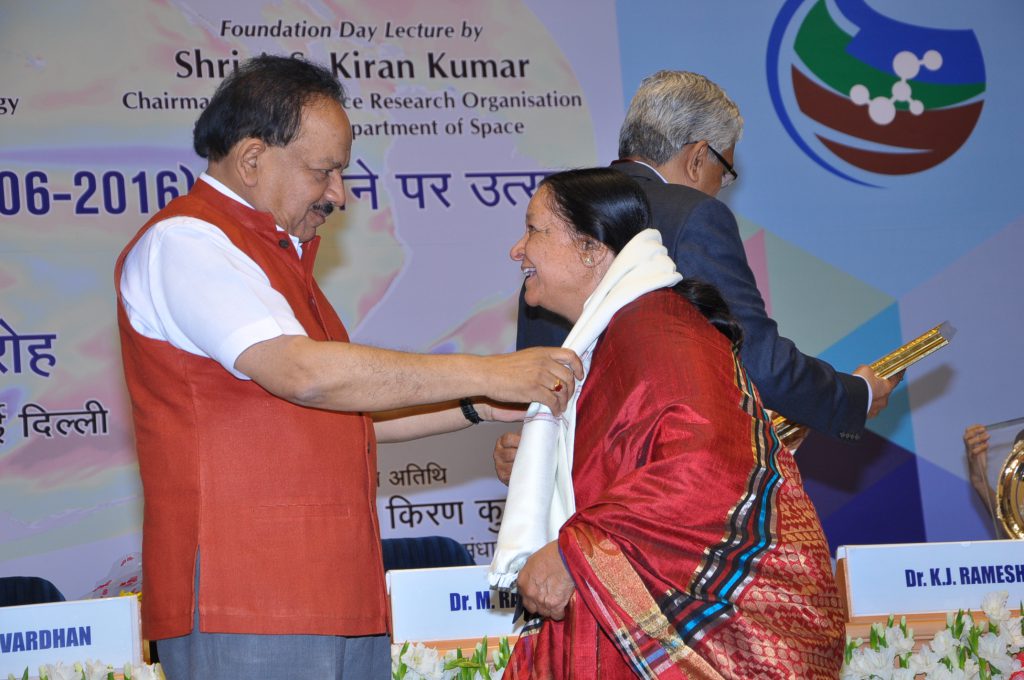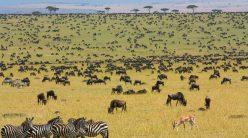
Sulochana Gadgil is a meteorologist with a large and influential body of work on the Indian monsoon. Born in 1944 in Pune, she studied mathematics in India and the USA. After obtaining a PhD in Applied Mathematics at Harvard University, she worked as a Research Fellow in MIT. In 1971, she returned to India and worked in the Indian Institute of Tropical Meteorology in Pune before moving to IISc in 1973, where she has worked ever since. She played an important role in setting up and nurturing the Centre for Atmospheric and Oceanic Sciences (CAOS), was its Chair from 1989-1996, and worked as Honorary Professor from 2006-2011. Now, based in Pune, she continues to study the Indian monsoon.
How did the switch happen from mathematics to monsoon meteorology?
After an MSc in Applied Mathematics from Pune University, I was fortunate to get into one of the best schools in the world, i.e. Harvard University, for their PhD programme in Applied Mathematics. I chose to work on the dynamics of atmospheres and oceans and did a thesis on modelling of Gulf Stream Meanders. While in graduate school I had the opportunity to take courses from great applied mathematicians and also from Prof Jule Charney from MIT, who has made fundamental contributions to tropical meteorology. My husband (who was a graduate student in Biology at Harvard at the same time) and I had decided that after our studies we would return to India for good. Given that the monsoon governs the pulse of life in India and that I already had an excellent training in geophysical fluid dynamics, I naturally wanted to work on the monsoon. So I worked with Prof Charney for a year before returning to India as a CSIR pool officer at the Indian Institute of Tropical Meteorology (IITM).
For over 300 years, the monsoon had been viewed as a land-sea breeze. In 1980, you co-authored a landmark paper that completely overturned this idea. What was it like to come out with findings that went against what everyone had been taught?
That paper was the result of collaboration with DR Sikka from IITM, who was one of the world’s leading monsoon meteorologists. In Pune, I got to know most of the meteorologists including stalwarts like Sikka and PV Joseph and the process of learning about the monsoon system began with collaboration with Sikka on many facets.
Perhaps the biggest opportunity of my career was an offer in 1973 from IISc to join as a faculty member at the newly started Centre for Theoretical Studies (CTS), which was because of Prof Satish Dhawan’s [IISc’s Director at the time and a leading aerospace scientist] interest in the monsoon and in nurturing atmospheric science at IISc. Prof Roddam Narasimha [a fluid dynamicist at the Department of Aerospace Engineering] took great interest in our work on the monsoon and the visitor’s programme at CTS enabled me to collaborate with people like Sikka and Joseph. The paper you mention was based on a study of daily satellite imagery of several years over the Indian region, in which we were able to demonstrate that the monsoon is a manifestation of the seasonal migration of a planetary scale system which is seen over non-monsoonal regions as well.

Your approach to studying the monsoon is very interdisciplinary – mathematics, meteorology, oceanography, agriculture, economics and more figure in your studying of the monsoon. What drives this?
If you are studying the monsoon and are passionate about really understanding the monsoon and its variability, you have to be interdisciplinary in your approach. The monsoon is a complex atmospheric phenomenon which has strong links with the cloud-bands over the equatorial Indian Ocean, the Arabian Sea, Bay of Bengal as well as the tropical Pacific. It was therefore natural to study what determines the cloud bands over tropical oceans and particularly those oceanic regions surrounding our subcontinent. In 1984, we did a study – with the very first available satellite-derived data set on cloud systems – of the nature of the relationship of such cloud systems to the surface temperature of the oceans beneath. It was carried out in collaboration with Joseph and a young mathematical modeller NV Joshi at IISc, and it showed that the sea surface temperature had to be higher than a threshold of 27.5°C for such cloud systems to occur and once the oceans are warmer, the variability of the cloud systems did not depend on the temperature. Subsequently this relationship has been proven to be correct with the very latest data sets available.
Part of your work has also involved assessing the economic impact of the monsoon and interacting with farmers to develop strategies appropriate to monsoon variability, such as choice of sowing window. Could you say more about that?
While it is well known that the monsoon has a large impact on the Indian economy, a quantitative assessment of its impact on GDP was not available. I therefore made such an assessment in collaboration with my son Siddhartha Gadgil, a mathematician who is now at IISc. We found that despite a substantial decrease in the contribution of agriculture to GDP over the last six decades, the impact of droughts has remained between 2-5% of GDP from the 1950s onwards. Since the impact on the economy is primarily because of its impact on rainfed agriculture, there is a need to understand, in depth, the relationship of the vagaries of the monsoon to agricultural production. In collaboration with an ecologist-farmer, Seshagiri Rao, I studied this relationship focussing on rainfed groundnut farming using a crop model. With inputs from leading farmers of the Pavgada region [in Tumkur district, Karnataka], we developed a model to assess the impact of pests and diseases triggered by wet and dry spells. We could thereby answer questions posed by farmers such as the choice of sowing window and in general identify farming strategies which could maximise yield/profit in the face of the rainfall variability in the region.
You were closely involved in the establishing of the Centre for Atmospheric and Oceanic Sciences at IISc. What were the early years of the Centre like?
Prof Narasimhahad nurtured interactions between his colleagues in Aerospace and me right from when I joined IISc. A natural outcome of the realisation of the challenges of the monsoon as a problem in geophysical fluid dynamics was the setting up of the Centre for Atmospheric Sciences [later renamed the Centre for Atmospheric and Oceanic Sciences – CAOS] in 1982. In the early days, CAOS had faculty members from various departments who were interested in the monsoon such as boundary layer experts from Aerospace Engineering, Prof Narayan Iyengar from Civil Engineering who started work on rainfall variability and prediction – which he is successfully carrying out to this day. Perhaps the most important [development] for CAOS was Prof J Srinivasan joining IISc’s Department of Mechanical Engineering in 1982 and playing a lead role in developing CAOS’ research on monsoon dynamics and its modelling. The joining of Prof GS Bhat, who had deep insight into turbulence, and particularly the physics of clouds, as a faculty member made a big difference to CAOS at that point. It meant we had expertise in most of the critical areas. CAOS has continued to grow with excellent faculty in physical oceanography and modelling as well as aerosols, geophysical fluid dynamics, hydrology and climate change. I have thoroughly enjoyed and continue to enjoy the interaction and collaboration with all my colleagues.
What are you working on currently?
From 2003, I have worked in collaboration with PA Francis (then a student) and Prof PN Vinayachandran (a former student who had by then joined the faculty of CAOS) on the relationship of the year-to-year variation of the Indian summer monsoon with cloud systems over the equatorial Indian Ocean, and in particular a phenomenon we called EQUINOO, which is the see-saw of the clouding over the western and eastern part of the Indian Ocean. We showed that, like the well-known EL Nino mode, this mode plays an important role in determining the monsoon’s variability. In fact, the 2019 summer monsoon is a clear demonstration of the critical role of favourable EQUINOO in the rainfall over the Indian region with the all-India rainfall being 10% above the average. My research in the next few years will focus on EQUINOO, its evolution in the season, and its prediction.
What do you think has been the most meaningful achievement of your career so far?
I have thoroughly enjoyed working on the variability of the Indian monsoon for so many decades and have learnt enough to keep me going down the same path enthusiastically in collaboration with so many good scientists for whatever time I have left.
To read more articles in our series on the monsoon, click on the following links:
MONTBLEX: India’s First Major Monsoon Experiment
Interview with Syed Ameenulla: ‘Ours was a small group, like one family’
BoBBLE: ‘An Unusually Successful Cruise’
What an Adivasi Village in Chhattisgarh Can Teach Us about Sustainable Development
Decoding the Signatures of Monsoons Past in Fossils and Genes
Why Knowledge Isn’t the Barrier to Water Conservation
Chanchal Uberoi on Monsoon Melodies




